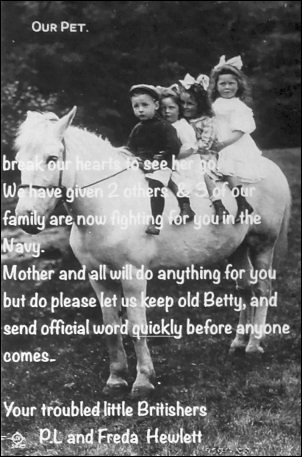|
Tue 14 Apr 2015
Graham Stirrup Ė Animals in
War. |
|
|
|
Graham started with a brief history of the start of World War
One. His presentation involved much video footage, including
London street scenes of the early 20th century. It was an
example, in this instance, of manís total reliance on horses as
a means of transport.
It also showed that armies on both sides were to become reliant
on horses as part of their forces. At the warís outbreak the
British army had 26,000 horses but quickly realised it would
need another 100,000. The country did not have enough horses so
many were bought from countries such as the USA, Argentina and
Australia.
Graham stated that during the course of the war up to 1 million
horses were shipped out of Dover to France. Also, more fodder
than ammunition went too.
However, these horses were not needed for cavalry charges, that
mode of war had gone forever. Horses were required, though, for
the transportation of supplies, weapons and ammunition. The
landscape had been transformed into a moonscape due to the heavy
artillery barrage. Horses proved to be better at coping with
these conditions than motorised vehicles of that time.
The war took its toll on horses as well as the men but it was
the weather and disease that accounted for more deaths than
enemy guns. |

Graham Stirrup |
|
 |

Trying to save the family pet |
After the war about 60,000 made in
back to Britain, most others being sold in France.
A mule, an offspring of a male donkey and a female horse, was
found to be a favourite pack animal because of its temperament
and physical attributes. The British army had just 1 at the
outbreak of war. By 1918, however, over 40,000 had been bought
and brought from the USA. |
Graham then described the many
uses that dogs were put to that included guard dogs. Dogs were
also a target from enemy fire when used as messenger dogs and
for laying telegraph cable.
By the Second World War dogs had been trained to detect mines
and, surprisingly, to parachute behind enemy lines to support
troops such as the SAS. |
|
In 1943 the
Red Army, in its desperate fight against the Germans, used
suicide dogs against tanks. They trained them to head for enemy
tanks fitted with explosives but this was not wholly successful.
An important way of sending messages was by pigeon and although
Germans used hawks to kill them, it was said that 95% got
through.
From the Middle East where camels were used to Burma where mules
and elephants transport heavy loads, animals proved their worth
in mechanized warfare.
Dogs still provide a vital role in modern warfare as a means of
detection in places, such as in Afghanistan.
To commemorate animals and the vital role they have played a
memorial was erected in 2004 on Londonís Park Lane. It is a
fitting tribute to animals that were not volunteers but were
pressed into the service by man to serve in his conflicts.
Peter Robinson |

"The camel can carry up to 450lb,
20 miles daily. Patient to a degree, enduring hunger, thirst &
pain with a stoical courage.
First sign a camel may give that he's being asked to do the
impossible ... is to drop down dead." |
|
|
|


